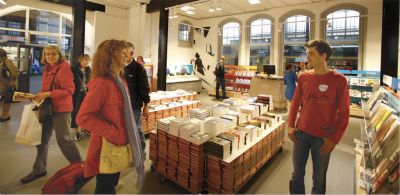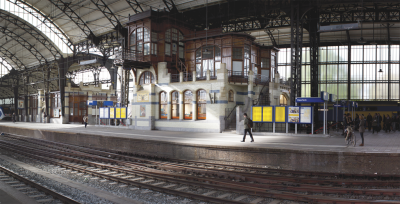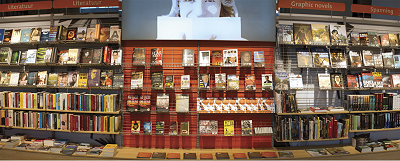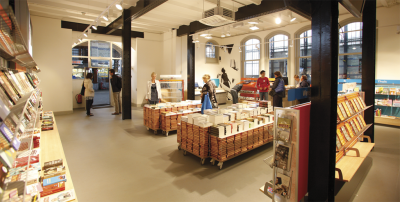 |
| Patrons and staff interact at De Bibliotheek
op het station in Haarlem. [photo by Sander Stoepker] |
 |
| In this panorama of the Haarlem train station, you can see the library situated between
the two sets of yellow signs, in the bottom floor of the building. [Photo by Floris Porro] |
 |
| Much of the collection sits facing out so commuters can make quick choices. [Photo by Floris Porro] |
 |
| Here’s a view from inside De Bibliotheek op het station in Haarlem. [photo by Sander Stoepker] |
In August 2011, a new type of library opened in the train station in the city of Haarlem in the Netherlands. ProBiblio, the service organization for public libraries in the west of Holland, led the project (www.probiblio.nl). We call it De Bibliotheek op het station (The Library at the station), but we also use Stationsbibliotheek (Train Station Library). This article will inform you about the concept, the marketing communication, and the results.
By 2006, the circulation numbers of the Dutch public libraries had been going down for several years in a row. The sense that librarians couldn’t just wait for the customers to come to their buildings was growing. Surveys revealed that customers were increasingly too busy to visit the public library as much as they had before. After that, ProBiblio, where I work, decided to investigate the feasibility of putting library branches at train stations. We knew that train commuters are readers—74% of them carry something to read regularly—but they also lead busy lives.
What’s more, ProBiblio learned from the beach libraries that a lot of positive publicity could be obtained from remarkable projects. (There are semipermanent beach libraries that aim to stimulate reading on the busiest Dutch beaches. They offer books, magazines, and activities and help make beaches more attractive even when the weather is not too good.) My organization confirmed this when it opened a public reference library in Amsterdam’s Schiphol Airport in 2010. [See www.airportlibrary.nl and the cover story in the July/August 2011 issue of MLS; http://tinyurl.com/AirportLibrary.]
The general purpose of De Bibliotheek op het station is to attract new customers by placing library services in the midst of the daily routine of busy readers, making them more accessible. It’s important to note that the Dutch national railway company NS (www.ns.nl) already sponsors several national reading promotion campaigns. So NS is an attractive partner.
The Initial Research and Concept
In 2008, our second attempt to reach the right people at NS finally led to action. We organized a meeting with managers of the libraries in the west of Holland who were interested in the idea of presenting services at train stations, and we did research. The qualitative research—holding three panel discussions with different age groups—taught us what demands a train station library would have to meet. First of all, it had to be a building where books could be loaned. Our quantitative research showed that 54% of the train commuters felt positive about the idea of train station libraries.
In 2009, we at ProBiblio developed the concept in cooperation with the five most interested libraries. These are the main characteristics of the concept:
- A small but very current collection (about 2,000 books, published not more than 2 years ago)
- Very easy and quick service, based on self-service and a very functional (mobile) website
- The ability to check the latest news
- Being open during the morning and evening rush hours
- Working toward a chain of connected, similar libraries with the possibility to borrow a book at one station and return it at another one
- We use a franchise formula in which ProBiblio owns the concept that it develops in cooperation with the local libraries, while those library partners own the station (paying costs and reaping benefits). ProBiblio helps by efficiently providing the shared services, including the overall collection management, publicity, the website, social media, etc.
The collection is, of course, limited in size and scope. Customers who want access to more media are directed to the branches of the city library by the website and the on-site staff member.
The train station library is set up like a retail shop. This means that most of the book covers are facing out. Frontal presentation is not only attractive, but it also means that customers who are in a hurry need less time to decide if a book is of any interest to them.
The library has five zones, starting with one where a customer only needs 20 seconds to return a book, choose a new one from the books just returned by other customers, and check out. These zones are part of the internal design and are not separated as such to users’ eyes. They are progressive areas that enable those super-fast transactions right near the doorway and enable longer stays in the areas farthest from the entrance. And so, the second zone contains a large display table with books that have been featured in the national media (newspapers and television). The third zone is a large display table with current bestsellers. The fourth zone contains bookcases with all the other titles and information on cultural activities in Haarlem. The fifth zone is the waiting room, with a large reading table, seats, newspapers and magazines, internet access, free Wi-Fi, and coffee and tea. Despite the small surface area (140 square meters, which is about 1,500 square feet) and the five zones, the library has a very simple layout that’s designed to serve customers in a hurry.
Free and Paid Publicity
After making the decision to start with a pilot installation at the central train station in Haarlem (a city of 150,000 inhabitants that’s 20 km/12 miles west of Amsterdam) and taking care of the financing (a special grant of €200,000 by the Province of North-Holland, which is about $261,000), the first library for train commuters in Europe opened on Aug. 8, 2011. We got a great deal of publicity in all of the local and national newspapers and on a number of radio stations that covered that soft opening, and there was more for the official opening in September. The stories had a very positive tone. We even made it to the national public television news, the highest mention you can achieve in the Netherlands. In 2011, we scored 258 media articles in both print and online media, both in the Netherlands and abroad. That was stunning, considering that our goal was to have 75 media articles during the whole pilot period of 2 years. And it was all free publicity, earned thanks to the power of remarkable projects.
The day after the official opening, we handed out several thousand leaflets to the commuters at the Haarlem train station, and we bought advertisement space (for some very large posters) for 1 week. At Dutch train stations, these are rather expensive actions, so we repeated the leaflet giveaway only twice in 2012. The average conversion is only 2%, so that’s why we have plans for other kinds of promotions. We are also doing search engine advertising on a limited scale.
Social Media Promotion
In addition to the mobile website (www.bibliotheekophetstation.nl), we use Twitter (@Stationsbieb) and Facebook (www.facebook.com/bibliotheekophetstation) to be present in the digital world. At first, we focused on Twitter, but we learned that Facebook is more appropriate for how and what we want to communicate. The train station library now has more likes than any other public library in the country due to two quite cheap advertising campaigns. The first campaign was aimed at the Likers of the train station library; the second was aimed at men on Facebook who live in Haarlem and mention reading as a hobby in their profiles.
We don’t use Facebook to attract new customers but rather to build a social community of train station library fans. But of course, a number of fans who get acquainted with the library in the virtual world also become customers.
We use the Facebook page to experiment and to gain insight for regular public libraries. At present, some public libraries use posts from the station’s Facebook page for their own Facebook pages.
Every month, we send a digital newsletter to almost all members, which has an open ratio of 51% and a click-through ratio of 12%. We have a deal with the city’s concert hall and its biggest theater. We choose one concert or performance each month that fits our collection or our target market and offer some free tickets to new library members along with a major discount to all existing members. This deal is published in both the library’s newsletter and the joint digital newsletter of the concert hall and theater, so it’s distributed to 15,000 addresses.
Results and Statistics
The main goal for the train station library in Haarlem was to attract 1,634 members within 2 years (when the pilot ends). After 5 years, the goal is 2,724 members, which is about 15% of the average number of unique commuters who get in and out of the train at Haarlem station on a working day (17,773 people). We can easily measure membership because people must pay to get cards for the train station library; they cannot use their regular city library cards there. An annual subscription card (good for a year) costs €40 (about $52 U.S.), and those who are already members of Haarlem’s city library can get it for €10 (about $13). Those who do not want to become members can borrow items for €2.50 each (about $3.25). And yes, we charge late fees: €0.40 (52 cents) per day, up to a maximum of €2 ($2.60) per week.
After 1 year, on July 30, 2012, we were behind on our goal: We had 797 members instead of the 1,090 that was our target (73% of our goal). We did a survey that summer to learn the possible cause of this and discovered that 57% of the train station’s visitors didn’t know about the library. The problem is that the library is situated at the west side at one of the platforms. Although it is the main platform and the west side is a high-traffic spot, travelers who always use the entrances and exits at the east side of the station do not easily get acquainted with the library. This problem can be solved partly by distributing leaflets more often, but that is relatively expensive. And putting up signs for the library is not possible (for safety reasons, only signs concerning the main processes at the train station are permitted), so we asked NS if we could use a temporarily vacant shop in the eastern corridor for promotion purposes, and we just got permission for that.
Although the amount of members is not meeting our goal, the amount of loans is twice as high as our goal. That shows that fewer members use the library more intensely than we’d anticipated. The reason seems to be the fact that when members return their books, they get a new one the same or next day. We have found that 29% of the members visit the library once or several times a week, and 6% do so every day.
User Satisfaction and Award Nominations
In September 2012, ProBiblio did an online customer satisfaction survey. The questionnaire was sent to 771 library members, and 218 responded. Here are some of the results:
- Sixty-one percent are reading more since becoming a member of the train station library.
- The general satisfaction rate is 8.7. (The target is 8+; the average score of Dutch public libraries is 7.9.)
- Happily, 89% of the respondents are certainly willing to recommend the library to others.
- The highest satisfaction scores were on user convenience, collection, staff, and interior.
- The lower satisfaction scores (but still satisfactory) were for open hours and the desire to be able to return books outside of open hours. (Current hours are 7–9 a.m. and 4–7 p.m., Monday through Friday.)
- The two main reasons for membership are convenience and the current collection.
The train station library was nominated for Best Library Project and for best railway service innovation (the Rail Award). Although we didn’t win, both occasions led to some free publicity. And the management of NS has expressed its wish for a network of at least 10 libraries and is offering us locations in big train stations.
What’s Coming in the Future
The main goal now is to complete the pilot in Haarlem, which involves these actions:
- We’ll optimize the concept based on the results of the user satisfaction survey, starting with adjusting the open hours and acting on some other wishes.
- We must find out how to attract more members to reach the goal of 1,634 members 2 years after opening, starting with a member-get-member campaign based on the high “recommendation willingness rate” and also improving the online marketing program. (The train station project is also a pilot for efficient marketing.)
- At the end of the pilot, we need to report all the results to the Dutch libraries that partnered with us and describe the concept of the train station library in detail in a formula manual.
To meet our second goal, we are making preparations for more libraries at the train stations where NS is offering us fairly reasonable rental prices. But in doing so, we meet one very big problem: Library budgets are limited because of the financial crisis. I’m afraid it will take some time before the network of 10 libraries is completed, if it will happen at all. This is the fate of many promising ideas that we had before the crisis.
|